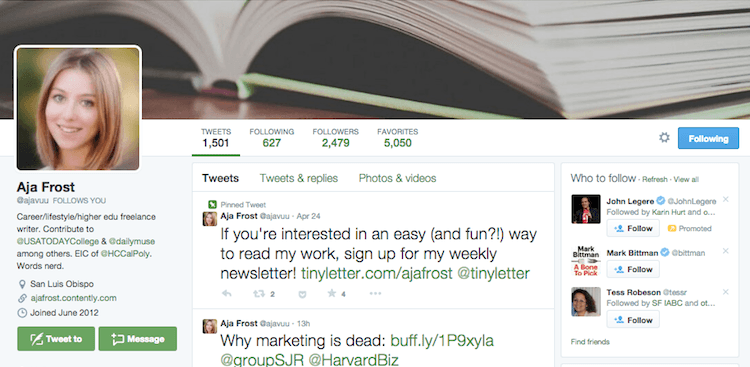Hopefully, by this point, we all know not to trumpet our political or religious views all over Twitter. We’re definitely not using the site to complain about our jobs, co-workers, or bosses. And if any of us ever posted inappropriate pictures on Twitter, they’re gone now. (If they’re not, check out tips on how to fix that problem today.)
But the rules of Twitter are constantly changing, and I see people make mistakes all the time. (I’ve even made a couple of them myself—oops.) So I’ve put together a Twitter “code of conduct” that’s filled with the rules that are a little less obvious. Consider this your guide to being the best version of yourself online.
Do: Repeat Tweets
I never used to recycle my posts, assuming my followers would unfollow me after seeing the same tweets over and over.
But that assumes people read every tweet in their feeds—which they don’t. There’s not enough time!
So, if you tweet something at 9 AM and again at 3 PM, you’ll be hitting different groups of people. Plus, reposting tweets also gives those in other time zones the chance to see your content.
Bottom line: Don’t be scared to post the same tweet a couple hours, days, or even weeks apart, as long as it’s still relevant.
Don’t: Tweet the Same Type of Content Again and Again
Your followers will notice, however, if all your tweets are the same type. For example, I unfollowed one guy because all he did was post article links—it got boring, fast.
As Belle Beth Cooper of Buffer explains, there are five basic “tweet types:” links, images, quotes, retweets, and original comments. As you experiment with these, you’ll quickly figure out which is most popular with your followers. Just make sure you’re not hitting any one type too heavily.
Do: Use a Ratio
To keep myself in check, I use the 30/30/30 rule: 30% original content, 30% retweets, 30% engagement. So I’ll post a link to an article, retweet something, and then tweet at an influential person.
Don’t: Confuse Your Followers
I lost a ton of followers when I spontaneously started tweeting about House of Cards. Most of the people who follow me are interested in career and productivity advice—not what I think about Claire Underwood’s character arc.
Now I’m always careful to make sure my tweets are relevant to my audience. To test this, look at the words in your bio. Do they match your last five tweets? Now, randomly choose 10 of your followers, and check out their bios. Do they match your last five tweets?
If you answered yes to both questions, you’re in good shape.
Do: Write a Good Bio
Speaking of bios, make sure you’ve got a good one. Your bio needs to tell people three critical things: who you are, why you’re an authority, and what your focus is. Basically, make your bio as specific and descriptive as possible.
Don’t: Only Promote Yourself
I absolutely love sharing links to articles by fellow Muse writers Lily Herman and Lily Zhang. It’s like an internet thumbs-up, and it also introduces my followers to some awesome content.
You don’t have to work with writers to promote your colleagues. Consider finding pieces you connections have written on LinkedIn, or their personal blogs, or on the company site.
In addition, you can tweet when someone in your network has done something cool.
Do: Inject Some Individuality Into Your Tweets
You know what’s boring? When you take an article, dump the link into a post, tag the author and the publication, and add the title.
Instead, put your own spin on it. Rather than tweeting:
Tweet:
The less formulaic you are, the better—I’ve found I get twice as many favorites and retweets and three times the number of clicks when I customize my tweets!
Don’t: Retweet Anything You Haven’t Read
I’ve definitely retweeted links to articles just because they have great titles. Then, when I go back later and actually read the article, I realize it’s either poorly written, has a misleading title, or worst of all, says something I adamantly disagree with.
Clearly, I get the appeal of seeing a cool-looking article, quickly firing it off, and moving on. However, if you want to make sure you’re sending the right messages, don’t retweet anything you haven’t at least skimmed.
Do: Shut Down Frequent Retweeters
What if you love a user’s original tweets—but get tired of all his or her retweets? Fortunately, Twitter has a setting that will block all of that user’s retweets from your feed.
All you have to do is go to his or her profile, click on the gear, and then select “Turn off retweets.”
Don’t: Ignore People
When someone tweets at you or mentions you, the worst thing you can do is ignore it. I’m always a little disappointed when I write a complimentary post or give a company a shout-out and hear crickets in response.
I know you’re busy, so just favorite the tweet if you don’t have the time to respond. If you do, I strongly encourage you to say something, even if it’s as brief as, “Thanks so much!”
It’s no accident brands make a point of interacting with their customers on social media—it drives brand loyalty up the wazoo. And hey, your personal brand could use some fans, too!
Do: Ignore the Spammers
That’s not to say you have to acknowledge absolutely everyone. When people ask me to follow them, it would be weirder to favorite their tweet and not also follow them, rather than just pretend I never saw the tweet at all.
(Bonus tip: Don’t ever ask anyone to follow you.)
And if someone is hostile, I don’t engage either. Most of the time, responding to angry or irrational people just spurs them on.
Don’t: Be a Stalker
When you’re trying to reach out to someone, it’s easy to come on too strong. But as Herman explains, “you don’t need to favorite or retweet everything that appears on your feed from a particular person, nor do you have to respond to every single tweet he or she writes. You’d be really freaked out if someone did that to you, right?”
I also think it’s weird when people favorite a bunch of my tweets from two or even three years ago. Let’s stick to the present!
Do: Follow the Companies You’re Interested In
You should definitely follow each and every company you’d like to work for—you’ll be one of the first to know about open positions, you’ll get valuable insights into their cultures, and you’ll stay up-to-date on their news.
Here are 31 to get you started.
Do: Use People’s Names
I’m a big believer in taking the extra two seconds to click over to a user’s profile, find his or her first name, and use it in my response. It makes the interaction feel friendlier and more genuine.
I’d much rather read, “Totally agree, Aja!” than “Totally agree!”
Don’t: Forget the Power of an Emoticon
As we all know, it’s super easy to send the wrong impression over text. Emoticons in email may not be super professional (depending on whom you’re talking to and where you work), but there’s no doubt they are kosher on Twitter.
Honestly, I love inserting smiley faces in my tweets to other people. The slightly cold, “Sorry, I’m not aware of any jobs in Colorado right now,” instantly becomes the warmly apologetic, “Sorry, I’m not aware of any jobs in Colorado right now. :) ”
Don’t: Swear
While Twitter is definitely a more casual environment, I still cringe whenever I see a professional swearing. Not only should you obviously not use the intense swear words, you should also refrain from the a-, s-, and d-words.
By the way, I’d also stay away from “moderate” swear words like “crap,” “Jesus Christ,” “freaking,” or “pissed off.” They just don’t sound professional—and you never know who you might offend.
Do: Stay Positive
I’m occasionally tempted to tweet things like, “Unannounced @Windows update means I can’t use my computer for the next hour. This is why I love PCs #sarcasm.”
While that statement might be mildly entertaining (to me, at least), it’s also whiny—and I’d rather keep my professional reputation as whine-free as possible.
No one’s going to follow you for being positive. But people will unfollow you for being negative.
Don’t: Neglect These Key Tools
There are plenty of tools and apps out there that will help you really up your Twitter game. Here are a few of my personal favorites:
-
ManageFlitter will pull up inactive accounts and people who haven’t followed you back.
-
SocialBro will tell you the best times to tweet.
-
SocialRank will let you in on who your most influential, engaged, and “best” followers are, so you can target them accordingly.
-
Twtrland will grade your activity, popularity, and responsiveness.
-
Nuzzel will show you what people in your network are talking about.
-
BuzzSumo will find the most influential people tweeting about any given topic.
Do: Use Photos
This one is actually something I’m working on myself. According to a study done by Buffer, when you include a photo in your tweet, you get 35% more retweets.
Plus, having a picture in your feed every once and while makes it much more visually interesting. My problem is that including pictures takes extra time—so I’ve committed myself to the very manageable goal of one tweet-photo a day.
Check out this list of 53 free image sources that you can use on your social media accounts.
Don’t: Repost Instagram Links
That same Buffer study showed that when tweets include Instagram links, people actually engage with them less. If you’re dead-set on having your Instagram posts show up on your Twitter page, however, you can use this IFTT “recipe.” All you have to do is tag your Instagram post “#tw,” and your photo will show up as an actual photo on Twitter, rather than a link to your original Instagram post.
Did I miss anything? Tell me in—what else—a tweet!

